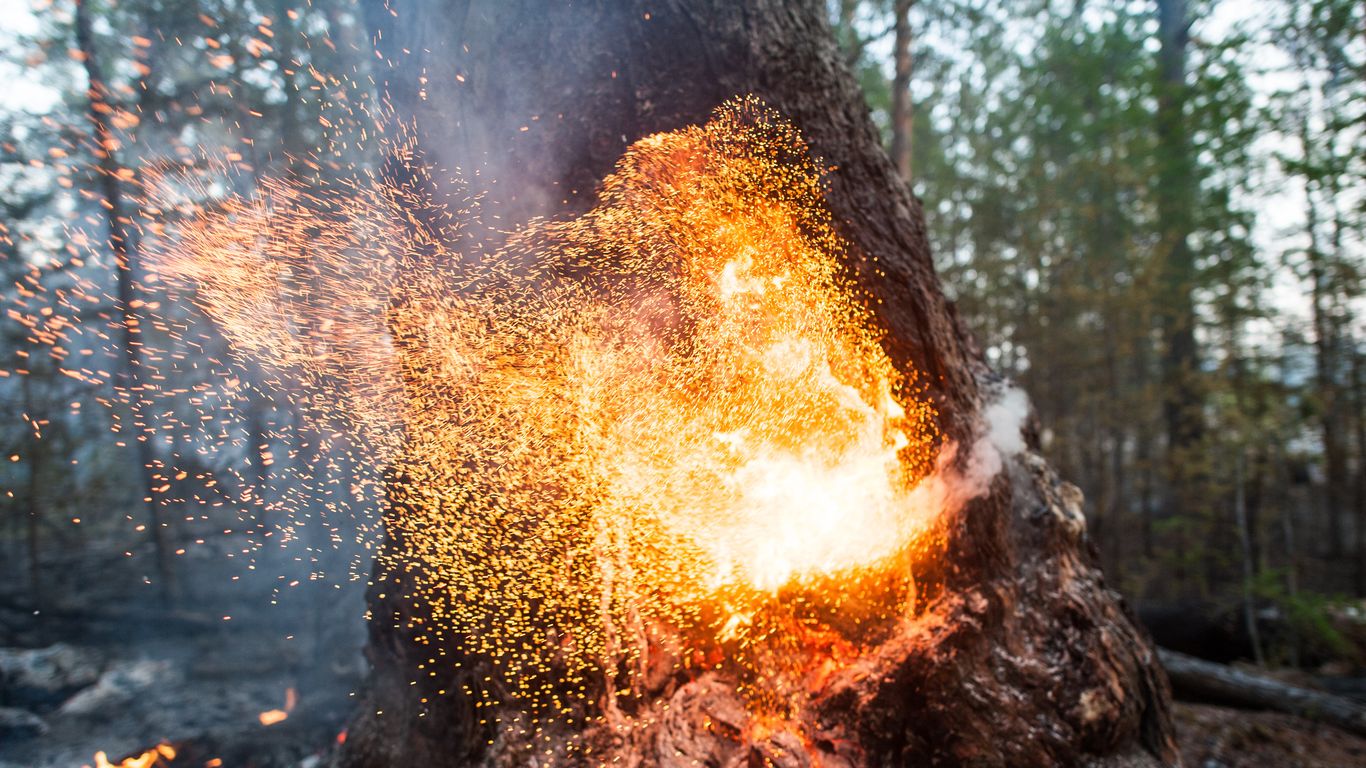Wildfires across parts of the U.S. and Canada are burning unusually intensely and emitting larger amounts of carbon dioxide into the atmosphere than typical during midsummer, scientists say. Massive blazes in Siberia are also adding more greenhouse gases to the atmosphere, while contributing to local air pollution.
Why it matters: The fires are thriving in areas experiencing extreme heat and drought conditions. They are both a consequence of climate change and an accelerant of global warming.
Driving the news: About 300 wildfires are burning in British Columbia alone, and about 80 large fires are burning in the West. In Siberia, which has been a planetary hot spot since the start of the year, intense and widespread wildfires have broken out, particularly in the Sakha Republic.
- At times, these blazes have reduced visibility in populated areas, such as Yakutsk, to near zero.
- Satellite observations and computer models developed by scientists at the Copernicus Atmosphere Monitoring Service show that the fires in North America as well as in Siberia have been unusually severe this summer.
- The blazes in North America, in particular, have also been emitting higher amounts of greenhouse gases compared to what is typically seen at this point in an average wildfire season.
Context: In addition to their intensity and expansiveness, these fires have something in common — they’re thriving in environments that have seen persistent weather extremes that have clear ties to global warming.
- In the West, it’s drought and extreme heat, including a total of at least four noteworthy heat waves so far this summer — with more likely on the way.
- In Siberia, the above-average temperatures have been unusually persistent, lasting from winter straight through the summer.
- “I think this is a good example of how these extreme weather events can sit over a region for longer than historically normal, and this is not well captured by our models,” Merritt Turetsky, who studies Arctic ecosystems at the University of Colorado at Boulder, told Axios.
What they’re saying: Mark Parrington, who studies wildfires for the Copernicus Atmosphere Monitoring Service, a European agency, told Axios that in some places, the total estimated emissions from wildfires between June 1 and July 20 “are already comparable or greater than the summertime totals in previous years.”
- “In the more than 10 years that I’ve been monitoring wildfires in the boreal forests, I can’t recall a period where there was such widespread wildfire activity in both North America and Russia simultaneously,” he said.
The intrigue: There are increasingly urgent scientific questions about how the wildfires and unusual warmth in Siberia are affecting permafrost, which is the layer of permanently frozen soil that rings the Arctic.
- If the blazes are accelerating permafrost thaw, then frozen organic matter locked away for centuries or longer would begin to decompose, releasing greenhouse gases and worsening global warming.
- So far, the jury is still out on wildfires and melting permafrost in Siberia, though there are some warning signs, according to Turetsky. “What I have my eye on is how permafrost will respond in the next 5–10 years in response to this burning,” she said.
- “Time will tell if we are watching the beginning of a true regime shift for Arctic fires,” she said.
The big picture: Both the severe wildfire season so far in the Western U.S. and Siberia are not a fluke, as each has seen a string of extreme fire years.
- Jessica McCarty of Miami University in Ohio, who tracks Arctic fires using satellites, said the trends in the Sakha region are to burn more area, burn longer during the year, and for flames to encroach on areas they previously did not enter.
What’s next: The peak of the North American wildfire season is still to come, and in recent years, the Siberian fire season has extended into September and even early October.
- McCarty told Axios that as widespread as Siberian fires have been this year, they’re not on a record pace for emissions, at least not yet. If fires maintain the same pace through September and October, she said, “We are looking at emissions less than 2020 but still equivalent to total CO2 emissions for many individual countries.”
- “Fire is not new to people living in Siberia, but fires every summer with increasing fire risk stretching from the steppes in the south to the Arctic Ocean in the north is new.”
Go deeper: Welcome to our hellscape summer
